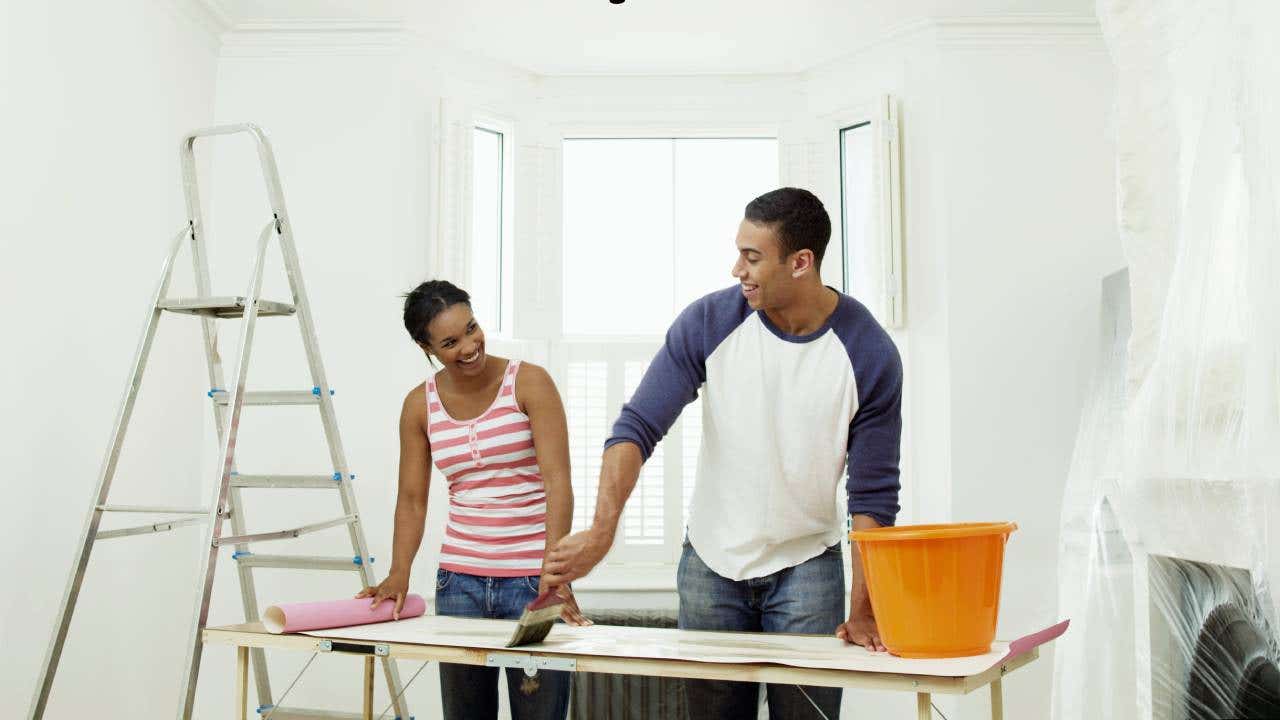Pros and cons of home improvement loans: Are they worth it?

The Bankrate promise
At Bankrate we strive to help you make smarter financial decisions. While we adhere to strict , this post may contain references to products from our partners. Here's an explanation for .
Key takeaways
- A home improvement loan can provide quick funding and flexible repayment options to homeowners.
- Home improvement loans may come with higher rates and fees for borrowers with bad credit.
- These loans can help build your credit and increase the value of your home, but they also have potential drawbacks such as high fees and secured options that put your assets at risk.
Home improvement or home renovation loans are a type of loan that allow you to use your borrowed funds to finance work around the house. You may fund everything from small renovations to basement conversions.
Personal loans are one common type of home improvement loan, but other types like home equity loans and cash-out refinancing offer their own perks.
Like all loans, home improvement loans have downsides. For example, if you don’t have stellar credit, it’s likely that you’ll be offered high interest rates and fees if approved. Before applying, weigh the pros against the cons to determine if they’re the right fit for you.
Pros and cons of home improvement loans
Home improvement loans are an essential tool for many people who may not be able to build up their savings. But even if you can score low rates, they may still be risky if you struggle to keep up with payments or borrow too much.

Pros
- Helps build credit.
- Finance a large project.
- Add value to your home.
- Fixed payments.

Cons
- Potentially high fees.
- Potentially high interest rates.
- Some loans are secured.
- Negative impact on credit.
Home improvement loan benefits
Home improvement loans are an important tool for homeowners who need to make essential or cosmetic changes to their space.
Helps build credit
On-time payments will always be a great way to improve your credit score and can make future borrowing less expensive.
In addition, depending on which sort of home improvement loan you choose, you can build your credit by expanding the types of credit accounts you have.
If your only current debt products are credit cards, a home improvement installment loan can diversify your credit profile. Your credit mix makes up 10 percent of your overall FICO credit score, while age and mix make up 20 percent of your VantageScore.
Finance a large project
Some lenders offer up to $100,000 in personal loan funds. However, this isn’t a common maximum amount, and not everyone will be able to qualify for such a large loan.
If you have significant equity in your home, you may be able to borrow even more with a home equity line of credit (HELOC) or home equity loan.
You should only pursue such a large amount if you have the income to afford the monthly payments. Use a personal loan calculator to compare what your payment would be with different loan terms and interest rates.
Add value to your home
A home improvement loan can help you increase the value of your home through tackling a more extensive project than you could otherwise save for. What’s more, if you plan to sell your home, you can recoup some of what you spent — and make your home stand out more on the market.
But buyers value some renovations more than others. The home improvements that add the most value include minor kitchen renovations, basement conversions and energy-efficient improvements.
Fixed payments
Home improvement personal loans and home equity loans are fixed-rate installment loans, meaning you’ll be on the hook for a predetermined monthly payment amount.
Installment loans can be the better financing solution for smaller, short-term projects. Multi-stage renovations may be better funded with a home equity line of credit.
Home improvement loan drawbacks
Home improvement loans aren’t for everyone. Factors like fees, high rates and hard credit pulls can detract from the loan’s value to you and cause financial stress down the road.
Potentially high fees
Not every lender charges the same fees. Your loan may have an origination fee deducted from the total amount you receive or added to the amount you borrow.
Some lenders may also charge late fees and prepayment penalties. Both can be avoided. But a prepayment penalty makes it more challenging to save money on interest if you’re able to make payments ahead of schedule.
Potentially high interest rates
Home improvement loan interest rates can be as steep as 36 percent — especially for those with poor credit. The higher your interest rate, the more you will have to spend each month to finance your home projects.
Some loans are secured
Most personal loans are unsecured, which means they don’t require collateral. However, some loans are secured either by your home’s equity or by another asset, like a savings or investment account.
If you’re unable to pay your loan and enter default, the lender could seize your collateral to satisfy your debt. Even if a secured loan comes with lower rates, the risk potential is much higher and that’s a key factor to consider.
Possible negative impact on credit
Applying for a home improvement loan will result in a small drop in your credit when the lender does a hard pull. Increasing your credit utilization by using a HELOC or credit card can also decrease your credit score.
And if you miss any payments or default on your loan, your lender is likely to report this to the credit bureaus. Missed payments can stay on your credit report for up to seven years — and the better your credit was before, the further it will fall.
When to get a home improvement loan
Taking out a personal loan for home improvements may make sense in the following scenarios.
- You need money fast to cover emergency home repairs. Unsecured home improvement loans generally have fast funding speeds, which might make them a better funding option than some alternatives.
- You’re paying for a one-time home improvement project. If you need to borrow a lump sum of money to cover a project, a personal loan may be a good idea. For ongoing projects, consider a credit card, line of credit or HELOC.
- You prefer not to risk losing collateral. A home improvement personal loan is typically unsecured, so you won’t risk losing an asset, such as your home.
Types of home improvement loans
There are multiple types of home improvement loans beyond just personal loans.
-
Current average interest rate: About 12.2.
Unsecured personal loan interest rates are typically higher than those of secured loan types, like home equity loans and HELOCs. But they offer some perks in exchange. Funding times are faster, since the lender doesn’t have to assess your home’s value — which also means no closing costs. You’ll get a predictable payment because your interest rate is fixed. On the downside, the rates you receive and whether you qualify at all depend heavily on your credit score, rather than your home’s value. Few lenders offer repayment terms over seven years, which could make payments unmanageable for large projects. And, unlike with a HELOC or home equity loan, you can’t deduct personal loan interest on your taxes. -
Current average interest rate: About 8.5%.
Like a personal loan, a home equity loan disburses one lump sum you repay in fixed monthly payments. You put up your home as collateral, driving the interest rate down. This also may make a home equity loan easier to qualify for if you have poor credit. But if you default, you could lose your home. Also, closing costs are typically high. -
Current average interest rate: About 9%.
A HELOC is a secured loan and a revolving line of credit, meaning you draw money as needed. Interest rates are often low but typically variable, so they fluctuate with the market. As with home equity loans, the biggest downsides are that you could lose your home if you can’t pay what you owe and that closing costs can be expensive. -
Current average interest rate: About 7%.
Refinancing replaces your current mortgage with a new mortgage and interest rate. Using a cash-out refinance, you would take out a new mortgage for more than you owe on your house and use the difference to fund your home improvement project. But closing costs can be steep, and it may not make sense if interest rates are higher than what you’re paying on your current mortgage loan. -
Current average interest rate: Fixed; market rate.
This government loan is guaranteed by the Federal Housing Administration (FHA) and designed specifically for home improvements, renovations and repairs. The maximum amount is $25,000 for a single-family home, lower than most of your other options. You may need to provide collateral depending on your loan amount. But if you’re a low-to-middle-income homeowner, this may be the best approach. -
Current average interest rate: 20.75%.
On the surface, getting a new credit card may not seem like a good idea for funding home improvements because of their high interest rates. But if you have good credit, you may qualify for a card that offers a 0 percent introductory APR for a promotional period. These periods typically last between 12 and 18 months.But if you carry a balance at the end of the promotional period, you’ll have to start paying interest. That makes this strategy best for short- and medium-term projects where you have a good estimate of your expenses.
The bottom line
Carefully consider the potential impact that taking on more debt will have on your financial health. Even before comparing lenders and looking into the details, conduct a financial audit to ensure you can handle more debt.
If a home improvement personal loan is not the right route for your financial needs, consider alternatives like a home equity loan, HELOC, credit card or taking time to build up your savings.
Related Articles



